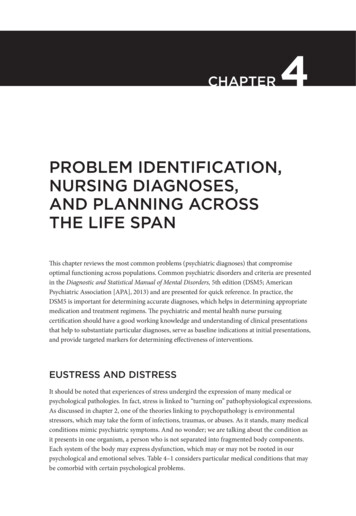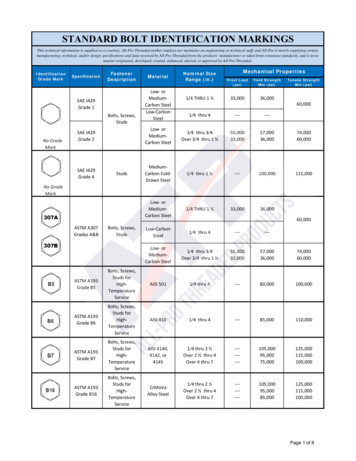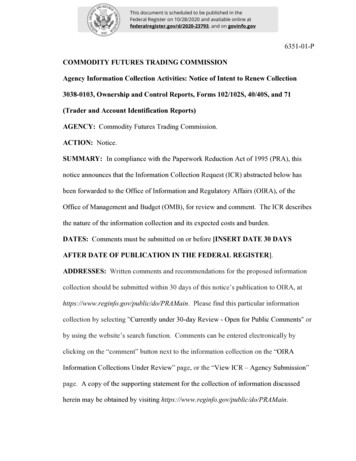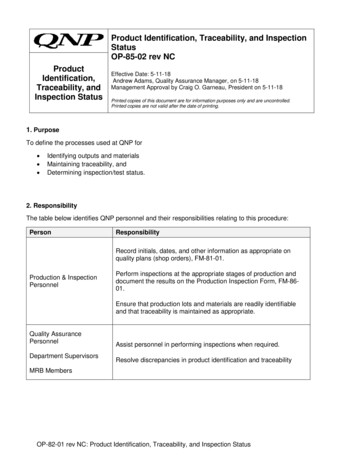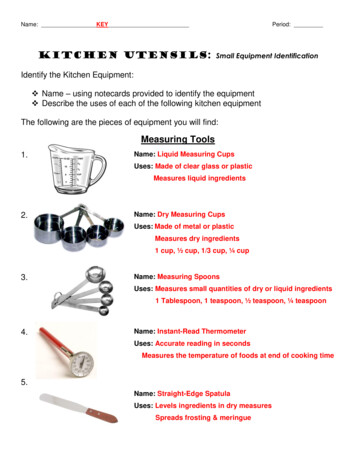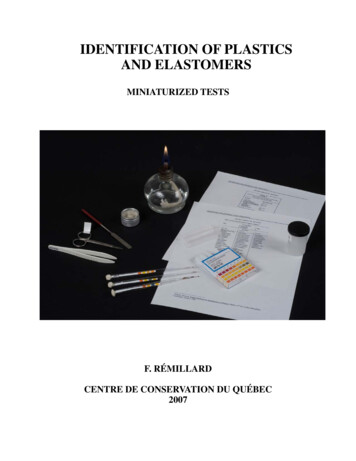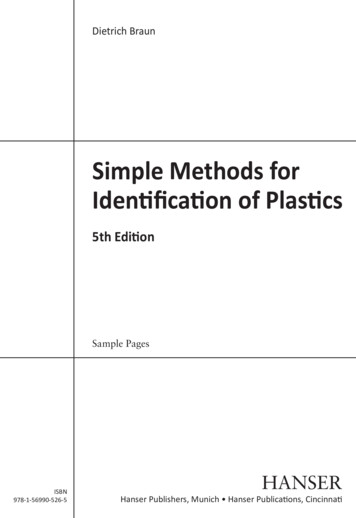
Transcription
Dietrich BraunSimple Methods forIdenƟficaƟon of PlasƟcs5th EdiƟonSample PagesISBN978-1-56990-526-5HANSERHanser Publishers, Munich Hanser PublicaƟons, CincinnaƟ
1Plastics and TheirCharacteristicsPlastics are high molecular weight (macromolecular or polymeric) organicsubstances that have usually been synthesized from low molecular weightcompounds. They may also have been obtained by chemical modification ofhigh molecular weight natural materials (especially cellulose). The rawmaterials are most o en petroleum, natural gas, and coal. They can bereacted with air, water, or sodium chloride to prepare reactive monomers.The most important industrial synthetic processes for the preparation ofplastics from monomers may be classified according to the mechanism ofthe formation reaction of the polymer, such as polymerization and condensation reactions. Since several chemically identical or similar plastics canbe prepared in several different ways and from different raw materials, thisclassification has little meaning for the analysis of unknown plastics samples. On the other hand, in addition to chemical investigations, the appearance of a plastic as well as its behavior on heating yields useful informationfor its identification.There are physical interactions between the individual macromoleculesthat constitute a plastic material, just as there are between the molecules ofa low molecular weight compound. These physical interactions are responsible for cohesion and related properties such as strength, hardness, andso ening behavior. Plastics that consist of linear threadlike molecules(several hundred nanometers (nm) long and a few tenths of a nanometer indiameter) (1 nm 10–9 m 10 Å 10–6 mm), i. e., of macromolecules, thatare not strongly crosslinked can usually be so ened on heating. In manycases they melt. Thus, when a polymeric material is heated above a certainbraun identification.indb 128.02.2013 10:38:53
21 Plastics and Their Characteristicstemperature, the macromolecules which are more or less oriented withrespect to each other at low temperatures can glide past each other to forma melt of relatively high viscosity. Depending on the degree of order of themacromolecule in the solid state, it is possible to distinguish between partlycrystalline and (mostly disordered) amorphous plastics (see Figure 1.1).This degree of order also has an effect on the behavior of the plastic on heating and on its solubility.Plastics that so en on heating and start to flow are called thermoplastics.On cooling, such plastics become solid again. This process can be repeatedmany times. There are several exceptions, as when the chemical stability(expressed in terms of the temperature at which chemical decompositionstarts) is lower than the cohesion between the macromolecules due to interactions between the chains, in which case, on heating, the plastic undergoes chemical changes before it reaches its so ening or melting work MeleculesIndividual Chain Moleculesamorphousamorphouspartially crystallineFIGURE 1.1 Schematic representation of the structure of plastics, showing the threemajor types of macromolecular arrangements. Approximately 1 000 000 times actualsize and greatly simplified. (Crystallites can also occur as the result of chain folding.)braun identification.indb 228.02.2013 10:38:53
1 Plastics and Their Characteristics3A further indication, with few exceptions, that macromolecules are linear orbranched is their solubility in many liquids, such as organic solvents. Thisprocess also reduces the interaction between the macromolecules; solventmolecules insert themselves between the polymer chains.In contrast to thermoplastic materials, there are the so-called thermosetting materials. These, a er processing into their final state, are crosslinkedmacromolecules that can neither melt nor dissolve. For such products onegenerally starts with liquid or soluble raw materials of a rather low molecular weight. These may be crosslinked by heating with or without pressureor through chemical reactions with additives and concurrent molding conditions. The results are crosslinked (hardened) high molecular weight materials in three-dimensional networks. These giant molecules can be brokendown into smaller and therefore meltable and soluble fragments only bychemical destruction of the crosslinks. This may occur at rather high temperatures or with certain chemical reagents. Thermosets o en containfillers that may strongly influence the appearance and properties of theproducts.Finally, we may distinguish the elastomers by their physical appearancewhich is a rubberlike elastic material that usually consists of relativelyweakly crosslinked macromolecules. Crosslinkages of natural or syntheticrubber are formed during the molding or vulcanization process. Because oftheir crosslinked nature, elastomers do not melt on heating until just belowtheir decomposition temperature. In this sense they behave differently frommany other elastic thermoplastic materials such as plasticized polyvinylchloride (PVC). In contrast to the chemically crosslinked elastomers (rubber), e. g., by sulfur or peroxides, network formation in the so-called thermoplastic elastomers (TPE) occurs through physical interactions betweenthe macromolecules. On heating, the physical interaction forces betweenthe chain molecules decrease, so that these polymers can be thermoplastically shaped. On cooling, as the physical interaction between the moleculesbecomes stronger, the material again behaves like an elastomer.Table 1.1 lists the most important characteristics of these three groups ofpolymeric materials. In addition to elasticity, behavior on heating, density,and solubility can be used to differentiate between these materials. However, it should be kept in mind that fillers, pigments, or reinforcing agents,braun identification.indb 328.02.2013 10:38:53
braun identification.indb 4(Usually) tightlycrosslinkedmacromolecules(Usually) lightlycrosslinkedmacromoleculesThermosets(a er processing)Elastomers**Rubber-elastic andstretchableHard; usually contain fillersand are opaque.Without fillers they aretransparentAmorphous:colorless; clear and transparent without additives;hard to rubbery (e. g., onadding plasticizers)Partially crystalline:flexible to horn-like; hazy,milky to opaque; only thinfilms are transparentPhysical Appearance*0.8 – 1.3Do not flow until closeto temperature wherechemical decomposition occursRemain hard andalmost dimensionallystable until chemicaldecomposition sets inheat-sealable (exceptions exist)0.9 – 1.91.2 – 1.4;filled:1.4 – 2.0Material so ens;fusible and becomesclear on melting;o en fibers can bedrawn from the melt;Insoluble, but will o enswellInsoluble, do not swell oronly slightlyMay swell; usually difficult to dissolve in coldsolvents, but usuallyreadily dissolves on heating the solvent, e. g.,polyethylene in xyleneSoluble (with few exceptions) in certain organicsolvents, usually a erinitial swellingBehavior on Heating Behavior on Treatingwith Solvents0.9 – 1.4(except PTFE:2 – 2.3)Density(g /cm3)* A rough measure for the hardness of a plastic is its behavior when scratched with a fingernail: hard plastics scratch the nail; hornlike plasticshave about the same hardness; flexible or rubbery plastics can be scratched or dented with a fingernail.** The behavior of thermoplastic elastomers is described on page 3.Linear orbranched macromoleculesThermoplasticsStructureTABLE 1.1 Comparisons of Different Classes of Plastics41 Plastics and Their Characteristics28.02.2013 10:38:53
4Testing forHeteroatomsThe previously described simple screening tests are not always sufficient toidentify an unknown plastic with certainty. In some cases the use of chemical reactions for identification purposes cannot be avoided. First, one testsfor heteroatoms, those elements which are present in the plastic in additionto carbon and hydrogen, such as nitrogen, sulfur, chlorine, fluorine, silicon,and sometimes phosphorus. Unfortunately, there is no simple direct methodfor the certain identification of oxygen, so it is not possible to test for oxygenin a qualitative manner. The following reactions presuppose a certainamount of experimental skill and the necessary care.For the qualitative determination of the elements nitrogen, sulfur, andchlorine, the Lassaigne method is usually used. Combine approximately50 – 100 mg of a finely divided sample with a pea-sized piece of sodium orpotassium in a pyrolysis tube. Heat this carefully in a Bunsen flame untilthe metal melts. (Caution: Wear safety glasses and keep the opening of thetube directed away from the eyes.) The sample must be free of water, whichwould react explosively with the metal. Sodium and potassium must bestored in oil or immersed in a similar inert hydrocarbon. When used, asmall piece of the metal is held with tweezers and the required amount iscut off with a knife or a spatula onto a piece of filter paper. Then carefullyblot it dry with the filter paper. Use it immediately and return the remainder to the oil-containing bottle. The remainder should not be destroyed bythrowing it into water.A er heating, carefully place the red-glowing tube in a small beaker withapproximately 10 m distilled water. The glass tube will shatter and the reac-braun identification.indb 3728.02.2013 10:38:56
384 Testing for Heteroatomstion products will dissolve in the water. Unreacted metal will react with thewater; therefore, carefully stir with a glass rod until no further reactionoccurs. Then, filter the nearly colorless liquid or remove the liquid by careful pipetting from the glass splinters and carbonized residues. For the following tests, use approximately 1 – 2 ml of this original solution.NitrogenAdd a small amount (a spatula tip) of ferrous sulfate to a1 – 2 ml sample of the original solution and boil it quickly. Letit cool and add a few drops of 1.5 % ferric chloride solution.A er acidification with dilute hydrochloric acid, a precipitateof Berlin blue occurs. The presence of a small amount ofnitrogen will result in a light green solution from which aprecipitate then results, though only a er standing for several hours. If the solution remains yellow, there is no nitrogen present.SulfurThe original solution is reacted with an approximately 1 %aqueous sodium nitroferricyanide solution. A deep violetcolor indicates sulfur. This reaction is very sensitive; to confirm, add a drop of the alkaline solution of the sample underinvestigation to a silver coin. If sulfur is present, a brown spotof silver sulfide will form. An alternative procedure is to acidify the original solution with acetic acid (test with litmus orpH paper) and then add several drops of aqueous 2 M leadacetate solution or test with lead acetate paper. A black precipitate of lead sulfide or darkening of the paper indicatessulfur.The presence of sulfur in polysulfides, polysulfones, and insulfur-vulcanized rubber can be demonstrated by the following somewhat uncertain test. The sample is heated in dry air(pyrolysis) and the gases formed during this process are bubbled through a dilute barium chloride solution. The presenceof sulfur is indicated by a white precipitate of barium sulfate.Chlorinebraun identification.indb 38This is a general test for heavier halogens, but bromine andiodine almost never occur in plastics. Acidify a sample of theoriginal solution with dilute nitric acid and add a smallamount of silver nitrate solution (2 g in 100 ml distilled28.02.2013 10:38:56
4 Testing for Heteroatoms39water; keep the solution in the dark or in a brown flask). Awhite, flaky precipitate that dissolves again on the additionof an excess of ammonia indicates the presence of chlorine. Alight yellow precipitate that is difficult to dissolve in ammonia indicates the presence of bromine. A yellow precipitatethat is insoluble in ammonia is characteristic for iodine.FluorineAcidify the original solution with dilute hydrochloric acid oracetic acid and then add a 1 N calcium chloride solution. Agel-like precipitate of calcium fluoride indicates the presenceof fluorine (compare also below).Phosphorus On the addition of a solution of ammonium molybdate to aportion of the original solution that was acidified with nitricacid, one obtains a precipitate on heating for approximately1 min. To prepare the molybdate solution, dissolve 30 g ammonium molybdate in approximately 60 ml hot water, cool, andadd water to make 100 ml. Then add a thin stream of a solution of 10 g ammonium sulfate in 100 ml 55 % nitric acid(from 16 ml water and 84 ml concentrated nitric acid). Let itstand for 24 hr, remove the supernatant by suction or bydecantation, and keep the solution well sealed in the dark.Siliconbraun identification.indb 39Mix approximately 30 – 50 mg of the plastic sample with100 mg dry sodium carbonate and 10 mg sodium peroxide ina small platinum or nickel crucible (carefully). Melt it slowlyover a flame. A er cooling, dissolve the material in a fewdrops of water, bring it quickly to a boil, and neutralize orslightly acidify it with dilute nitric acid. Add 1 drop of molybdate solution (see phosphorus test), and then heat nearly toboiling. Cool the sample, add 1 drop of benzidine solution(50 mg benzidine dissolved in 10 ml 50 % acetic acid; addwater to make 100 ml), and then add 1 drop of saturatedaqueous sodium acetate solution. A blue color indicates silicon.28.02.2013 10:38:56
404 Testing for HeteroatomsOther Identification ReactionsHalogens, especially chlorine and bromine, can be easilyidentified with the very sensitive Beilstein test. Heat the endof a copper wire in a Bunsen flame until the flame is colorless. A er cooling, put a small amount of the substance to beexamined on the wire and heat it at the edge of the colorlesspart of the flame. When the plastic burns, the presence ofhalogen can be inferred if the flame is colored green or bluegreen.Fluorine can be demonstrated by placing approximately 0.5
4 1 Plastics and Their Characteristics TABLE 1.1 Comparisons of Diff erent Classes of Plastics Structure Physical Appearance* Density (g /cm 3) Behavior on Heating Behavior on Treating with Solvents Thermo- plastics Linear or branched macro- molecules Partially crystalline: fl exible to horn-like; hazy, milky to opaque; only thin fiFile Size: 514KBPage Count: 15


